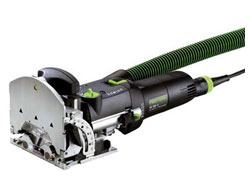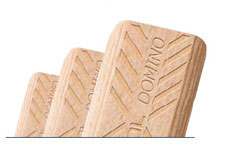
A few weeks ago, a reader asked what was the most efficient, fastest and easiest way to cut mortises and tenons on a production scale. That would have been a tough question a year or two ago, but as of April second of this year, there’s a simple answer: the Festool Domino joiner.
Touted as the quickest, easiest and ultimately cheapest way to make accurate mortise and tenon joinery, Domino has been making a splash on print and web site ad pages for the past few weeks. The buzz is that Domino appears to be the most revolutionary advance in joinery since the biscuit, and one that makes a giant leap forward from that technology.
To get some firsthand information, I called Bob Marino, a former woodworker and a regular on woodworking message boards. In fact, he is known as the “go-to guy” for online Festool advice, and one of the country’s largest dealers. All Festool dealers are allowed to sell anywhere in the country, but Bob says there’s a good reason he has such a loyal following.
“All the pricing is the same,” Bob explained, “so many of my customers come to me because of the service that I offer. I try to be honest with people, and make every attempt to make sure people buy the right tool for their needs. After the sale, I make certain that I give them support. On forums, I have tried to be more of a resource person than a sales person.”
It was not hard to get him to talk about the Domino. “Most woodworkers agree that mortise and tenon is one of the strongest joints available,” Bob pointed out, “but one that can be difficult and time-consuming to make correctly. On the other hand, biscuit joinery is one of easiest to make, but offers substantially less strength. Domino is the marriage of the best of both. The Domino looks a bit like a biscuit joiner, but in actuality it is the only portable floating tenon joinery machine on the market.
“The way it works is that a rotating and oscillating cutter plunges into the wood to cut a consistently uniform mortise. After both sides are cut, a pre-formed domino-shaped floating tenon is glued in. The tenon is solid beech stamped with extremely subtle ridges and markings that help hold glue. The face impressions become flush once waterbased glue is applied to make a solid joint. However, the tenon itself does not swell, a problem often associated with biscuits. The end result is a perfectly snug slip fit floating tenon every time, resulting in an extremely strong and easy to make joint.
“The dominos themselves come in five thickness and length combinations that correspond to four different bit options in the machine. The machine comes with the five mm cutter, which is fine for light work. Most purchasers in Europe, where it was first introduced, buy the assortment that comes with four cutters and 1,000 dominos. The four cutters are 5, 6, 8, and 10 mm. The lengths range from 30 mm for the five mm cutter to 50 mm for the ten mm. By adjusting the depth, the 8 mm cutter works with both a 40 and 50 mm domino.
“Any cut you can make with a biscuit joiner, you can make with this machine. Domino is essentially maintenance-free. The cutters themselves, which cost about 30 dollars, are carbide-tipped and will last for up to 5,000 cuts in hardwood, and up to 15,000 in softwood. Dominos themselves start at about three cents apiece, which makes them cheaper than the amount of wood used up in cutting a fixed tenon.
“The machine itself is loaded with features like an absolute indexing system that alleviates the need for marking, easy adjustment for angled cuts, and outstanding dust control when paired with the Festool dust collector.” That’s an important issue for Marino, who still works part-time as a respiratory therapist, his former career.
Festool is a relative newcomer in the U.S., but in Germany, they boast the largest market share across a wide swath of woodworking. Their entry into the American market was both tentative and a bit unusual in approach.
“Originally,” Bob recounted, “most sales agents were carpenters and professional woodworkers who were actually using the tools and showing them to coworkers on the job site. Until a couple of years ago, no one was allowed to stock tools. They were drop shipped from one of two warehouses. I would go out to shops and woodworking shows and do demonstrations of Festool tools, then sell them online. As the Internet grew, my involvement with Festool grew. One big break came when I demonstrated Festool to the Silva brothers of This Old House fame, and they started using them on the show.” Today there is a widespread dealer network across the country in addition to online sellers.
Not surprisingly, this sort of quality and innovation does not come cheaply. A package consisting of the machine, cutter assortment and dominos will set you back almost a thousand dollars. Clearly, this is a tool aimed at professionals and serious hobby woodworkers.
“Professionals will prize Domino for its savings in time,” Bob insisted, “while hobby woodworkers may see it as something that alleviates aggravation. I suspect that many hobby woodworkers will use the Domino to attempt joinery projects they might otherwise have avoided. With it, anyone can make floating tenon joinery flawlessly. Mortise and tenon joinery was never so safe, accurate, and dust-free.
“My prediction is that Domino will soon become the generic term for this type of machine in the same way that many people call all brands of reciprocating saws a Sawzall ™, and all nylon abrasive pads Scotchbrite™. I feel certain that this machine will change the way people do woodworking.”







